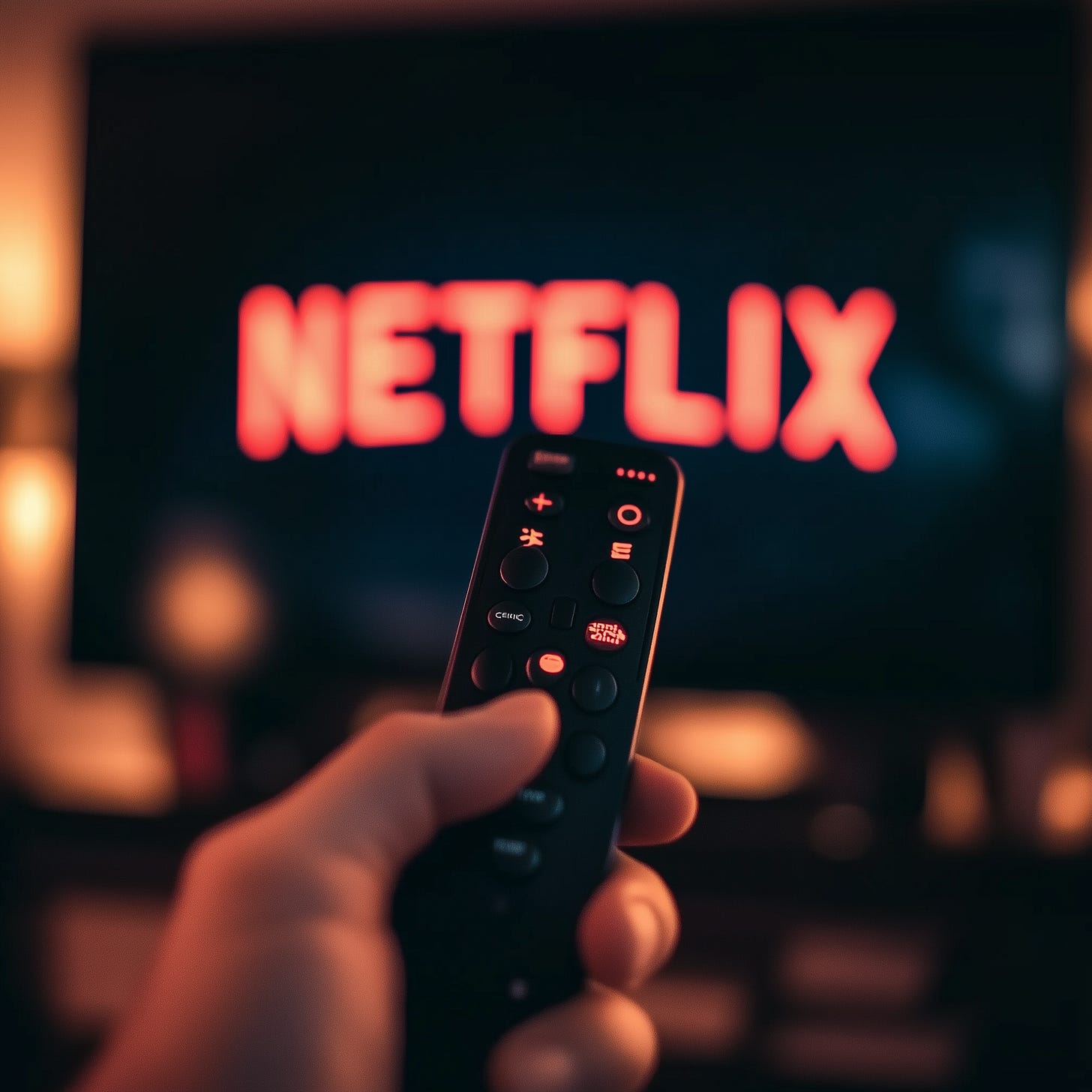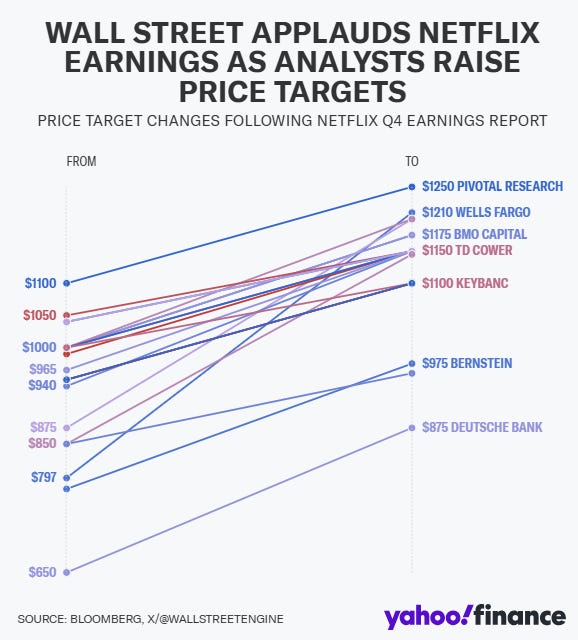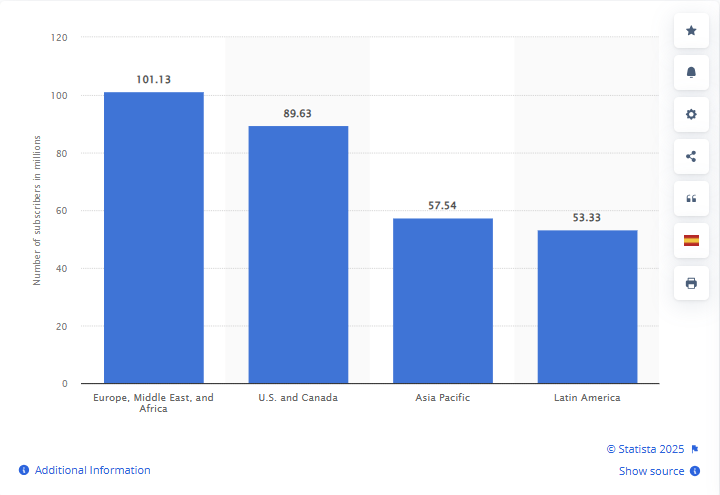How Netflix Turned Its Business Around When Everyone Thought It Was Done
A Leadership Story of Strategic Thinking and Innovation in Uncertain Times
Hi…
Welcome to TJ’s Innovation Zone 💡
My name is Tomer Jakov and during the last 15 years, I’ve been helping established companies, startups, and government to foster innovation in traditional industries. As an executive, and now as an advisor.
In this newsletter I share my professional insights, case studies breakdowns, and emerging technology trends to help and inspire you, as disruptor, to transform industries.
If you are a Startup Founder, Entrepreneur, Innovation leader, or simply an innovation enthusiast like me…
Netflix stock (NFLX) closed at an all-time high last Wednesday, surging nearly 10% following a strong earnings report.
The streaming giant reported a record-breaking 18.9 million new users in the fourth quarter, while revenue and earnings handily beat expectations.
This marked the largest quarterly subscriber gain in the company's history.
Shortly after the opening bell, the stock briefly touched $1,000 per share as analysts rushed to raise their price with Pivotal Research targeting $1,250 (the highest ever).
But the picture looked quite different just two years ago.
Netflix was bleeding subscribers.
Competition was intensifying from all sides.
And analysts had written off the company as a "has been."
What changed?
How did it happen so quickly?
Which actions led to the comeback?
Netflix's journey from a beaten streaming service in 2022 to a thriving entertainment powerhouse in 2024 offers valuable insights for business leaders navigating through challenging times.
In this week's article, I'll explore the strategic decisions and innovative approaches Netflix used to quintuple its share price, outpacing competitors on its way to all-time highs.
Let's dive in…
Listen to an AI-Podcast version of this article:
Hitting bottom
Netflix hit its bottom in May 2022.
Just a half year earlier Netflix's stock reached what was all-time high back then, trading at around $700 per share.
But from there, it was nothing less than a nosedive.
First, the stock dropped from $700 in November 2021 to around $400 in early 2022, driven by concerns about slowing subscriber growth.
Then came the dramatic crash in April-May 2022, when the stock plunged to $162.71 after Netflix reported its first subscriber loss in over a decade.
To put this in perspective, this decline wiped out nearly $200 billion in market value!!
Such a dramatic fall explains why many analysts at the time were questioned Netflix's future.
But the problem wasn't just about numbers…
The streaming landscape also changed dramatically.
Competitors like Disney+, HBO Max, and Amazon Prime were investing heavily in content and consumers had more choices than ever before. Password sharing had become a growing issue for Netflix, eating into potential revenue, and the pandemic streaming boom had ended.
The market was demanding a new approach.
The Turning Point
Instead of playing defence, Netflix's leadership team chose to reimagine their business model.
They understood that survival meant evolution.
Their response wasn't just about fixing problems…
It was about building a stronger, more versatile business for the future.
The company’s impressive comeback was the results of few key strategic decisions and an innovative mindset.
Here the key strategic shifts made by Netflix:
1. Embracing Advertising
Netflix broke with tradition and launched an ad-supported tier.
This wasn't just about offering a cheaper option...
It was about creating an entirely new revenue stream.
The move paid off dramatically.
By 2024, more than half of new subscribers in markets with the ad-supported tier chose this option.
While the income from subscribers may have decreased, advertising revenues more than compensated for this decline. The advertising revenue doubled year over year and is projected to double again in 2025
2. From Password Sharing to Profit Sharing
Instead of treating password sharing as a problem to eliminate, Netflix saw it as an opportunity to expand.
They developed features that allowed users to add paid sharing options to their accounts. This approach turned non-paying users into revenue-generating customers while maintaining user goodwill.
3. Beyond Traditional Streaming
Netflix made bold moves into new entertainment territories.
They ventured into live sports and events with remarkable success.
A prime example was the Mike Tyson vs. Jake Paul boxing match, which drew an unprecedented 65 million concurrent viewers (a record-breaking achievement that demonstrated Netflix's potential to excel in live entertainment).
While the actual broadcast experienced some technical challenges, Netflix viewed this as a valuable learning experience. The company used the insights gained to improve its infrastructure and enhance its ability to support high-peak demand streaming events.
Additionally, Netflix expanded into gaming by acquiring studios and launching games that complemented their existing content. This strategic move signalled the company's commitment to diversifying its entertainment offerings beyond traditional streaming.
In 2023, Netflix tripled its gaming engagement and set more aggressive growth goals for 2025 and 2026 and while gaming's impact on customer retention is still relatively small, Netflix sees it as a growing area.
4. Doubling Down on Quality
While expanding into new areas, Netflix didn't lose sight of their core strength - content.
They increased their investment in original programming to $17 billion in 2024, up 29% from the previous year. This commitment to quality led to 107 Emmy nominations and 24 wins, reinforcing their position as a premier content creator.
Innovation as a strategic advantage
As I mentioned in a previous post, strategy and innovation go hand in hand.
While Netflix's strategic moves grabbed headlines, their behind-the-scenes technology transformation played an equally important role in their comeback.
Their approach to innovation shows how modern tools can solve real business problems and create new opportunities:
Personalization at Scale
Netflix built systems that learn from every user interaction.
This isn't just about recommending shows...
It's about understanding what keeps customers engaged.
Their technology:
Tracks how people interact with content
Learns from viewing patterns
Adapts the user interface for each viewer
Creates different thumbnail images for the same show based on viewer preferences
This deep understanding of customer behavior helps Netflix reduce subscriber churn and increase viewing time.
Data-Driven Decision Making
Netflix uses advanced analytics to make better business decisions.
Their systems help:
Predict which new shows will succeed
Determine optimal investment in different types of content
Identify emerging viewer trends
Guide marketing spending
This approach takes the guesswork out of major business decisions, reducing risk and improving returns on investment.
Operational Excellence
Smart technology helps Netflix run more efficiently.
Their systems:
Predict and prevent streaming issues before they happen
Automate content localization for global audiences
Handle customer service inquiries automatically
Monitor platform security and detect unusual activity
These improvements reduce costs while maintaining service quality.
Content Creation and Development
Netflix uses technology to enhance their creative process.
Their tools help:
Analyze scripts for potential audience appeal
Guide casting decisions based on viewer preferences
Optimize production budgets
Identify opportunities for new content formats
This perfect blend between creativity and data helps Netflix produce content that resonates with audiences while managing production costs effectively.
Making the Ad-Supported Tier Work
The introduction of an ad-supported tier was a major strategic shift, but technology made it successful.
Netflix built systems that could analyze viewer preferences and behaviors to deliver personalized advertising experiences. This meant advertisers saw better results, and viewers found the ads less intrusive.
By the end of 2024, this technology-driven approach helped double their advertising revenue, with projections showing another doubling in 2025.
Solving the Password Sharing Challenge
When Netflix decided to monetize password sharing, they needed a way to identify shared accounts without alienating users.
Their advanced security systems could detect sharing patterns while their customer support technology helped make the transition smooth for users.
This technical foundation turned a revenue leak into a growth opportunity, bringing millions of new paying subscribers to the platform.
Keeping Viewers Engaged
Netflix knew that subscriber growth wasn't enough...
They needed to keep people watching!
Their personalization technology proved crucial here.
By analyzing viewing patterns, their systems could predict what content would keep subscribers engaged. This helped reduce subscriber churn during a critical recovery period.
The technology was so effective that it could even customize show thumbnails based on individual viewer preferences, increasing the likelihood that users would find content they enjoyed.
Going Global Efficiently
As Netflix pushed for international growth, their technology made it possible to scale quickly.
Their AI-powered dubbing and subtitling systems could adapt content for new markets faster and more cost-effectively than traditional methods.
This meant they could enter new markets rapidly while maintaining the quality their viewers expected.
The result?
Significant subscriber growth in regions like the Middle East and Africa.
The Human Touch in Technology
What makes Netflix's technology approach special is how they maintain the human element.
Their chatbots handle routine customer service issues, but they're designed to feel helpful rather than robotic. Their content recommendations feel personal because they're based on real human behaviors and preferences.
This balance between technological innovation and human understanding has helped Netflix create a service that feels both cutting-edge and deeply personal.
Leadership Continuity
The story of Netflix's recovery wouldn't be complete without understanding a crucial factor - leadership stability during turbulent times
While many companies rush to replace executives during crises, Netflix maintained its core team through the storm. Reed Hastings and Ted Sarandos, who had led Netflix through previous transformations, stayed at the helm during the critical period of 2022.
In January 2023, the company made a planned transition.
Reed Hastings moved to Executive Chairman, while Ted Sarandos continued as co-CEO, joined by Greg Peters in the same role. This wasn't a crisis-driven shake-up but a carefully orchestrated evolution.
The continuity proved valuable.
The team that understood the roots of the crisis engineered the comeback. Their deep knowledge of Netflix's culture and operations allowed them to make bold moves while preserving what made Netflix special.
Netflix's story shows that sometimes the best team to lead a transformation is the one that knows both your strengths and vulnerabilities.
True leaders don't just navigate through a crisis...
They use it as an opportunity to build a stronger organization.
Future Outlook
Looking ahead, Netflix is poised for continued growth and innovation
Netflix has laid out several strategic priorities for 2025, including the growth of its content slate, enhancing product experience, scaling its ads business, developing new initiatives in live programming and gaming, and growing the business sustainably.
More Price Hikes: Consumers in the US, Canada, Portugal, and Argentina are expected to see price increases in 2025
Content Expansion: Netflix has a number of big hits scheduled for release in 2025 including returning seasons of top-performing shows and new international projects
AI Integration: Continued investment in AI is expected to enhance personalization, content creation, streaming quality and user experience.
Leadership Lessons for Your Organization
The Netflix turnaround offers several key insights for business leaders:
A crisis can be your best opportunity for transformation. When the pressure is highest, bold moves become possible.
Never stop innovating, even in your core business. Netflix expanded into new areas while simultaneously strengthening their original content offerings.
Listen to your customers, but lead them to the future. Netflix didn't just react to customer complaints - they built solutions that created new value.
Technology should solve real problems. Focus on innovations that improve your core business and customer experience.
The true lesson from Netflix's transformation isn't just about the specific strategies they used. It's about the mindset that drove their decisions.
They faced their challenges head-on, thought creatively about solutions, and weren't afraid to break with tradition when necessary.
Your Next Move
As you think about your own organization's challenges, consider:
What opportunities lie hidden within your biggest problems? Which traditional practices might need rethinking? How could technology help you serve your customers better?
The next great business transformation story could be yours. Start by gathering your team and asking these questions. Remember, every successful turnaround begins with leaders who are willing to think differently and act boldly.
What will your organization's next chapter look like?
🎧Weekly Podcasts/YouTube Recommendations
⚡What’s Going On With Gemini Deep Research (Spotify Link)
✈️ Educating The Next Generation of Entrepreneurs (Spotify Link)
🗞️What else you should know…
🤖 Stargate project to heat up artificial intelligence race












